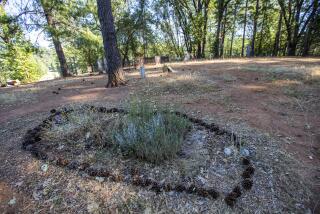Burbank Rejects Church Plea for Sanctuary Entombment
- Share via
BURBANK — The archbishop of the Syrian Orthodox Church knows exactly where he wants his body to be laid to rest when he dies: in a vault nestled discreetly behind the altar of a church in Burbank.
For 2,000 years, esteemed leaders have been honored with this type of entombment, say church leaders and members of the Burbank church who want to continue the practice.
“It’s in the heart of our tradition and religious belief that an archbishop should be entombed in the sanctuary,” said Pastor Joseph Tarzi of St. Ephraim Syrian Orthodox Church.
But in Burbank, that tradition may have died this week, when the City Council rejected a zone text amendment that would have allowed burials inside or underneath church property through a conditional-use permit.
In a 4-1 vote Tuesday night, the council let stand the current code that restricts burials to one cemetery zone in the city.
Members of the council and some residents expressed concern that allowing the entombment, even through the conditional-use process, would set a precedent that would make it difficult for the council to reject similar requests from individuals who might misuse the law.
“I think you’re opening a real Pandora’s box by getting involved in this issue,” said resident Ted McConkey, echoing a sentiment expressed by many.
But while church burials are rare in America, members of the Orthodox church say they are common in other countries.
“It falls more under the aegis of custom within a particular tradition,” said Father Catalin D. Mitescu, a faculty member at Pomona College and president of the Orthodox Clergy Council of Southern California. “Some churches have that as a practice in the old countries, generally for people relatively important from the church’s point of view.”
At St. Sophia Greek Orthodox Cathedral at Normandie and Pico in Los Angeles, two church members are entombed in a mausoleum next to the church, said Father Andrew Barkos.
The church is located in an area that was zoned for burials, Barkos said. “We’re next to a cemetery.”
Although Los Angeles zoning officials could not recall an instance where a church entombment had taken place, such burials are possible in the city under existing legislation, said Robert Janovici, chief zoning administrator.
A church could be granted permission through a conditional-use permit or “by right.”
“If it was normally an accessory function of the church to do that kind of thing, we would recognize the right for them to continue to do it,” Janovici said.
Although some members of St. Ephraim were disappointed with the Burbank council and the community’s reaction to their request, Tarzi said the council “has a right to make that decision.”
“If that’s their decision, we respect it,” he said.
And the council’s decision was not wholly unexpected.
Started in 1963 by immigrants from the Middle East, St. Ephraim is now the largest Syrian Orthodox congregation in the United States and Canada, Tarzi said.
The first church building was located in Los Angeles, then in Hollywood. It moved to Burbank 4 1/2 years ago. The 800 families registered at the church are scattered throughout Los Angeles County, with concentrations in Burbank and North Hollywood, Tarzi said.
Over the years, the church has had its fair share of bumpy rides with planning boards and communities. Tarzi speculated that part of the problem might rest with the public’s unfamiliarity with the church.
“We don’t do any activities that are different, but because people are not familiar with the name, they may think we are different,” he said.
The church has a Sunday school, a worship choir and youth activities like many other churches.
“It’s almost identical to a Protestant, Baptist or Methodist church or any other American church. We’re Christians,” Tarzi said. “A Christian church is a Christian church.”
Staff writer John Dart contributed to this story.
More to Read
Sign up for Essential California
The most important California stories and recommendations in your inbox every morning.
You may occasionally receive promotional content from the Los Angeles Times.












